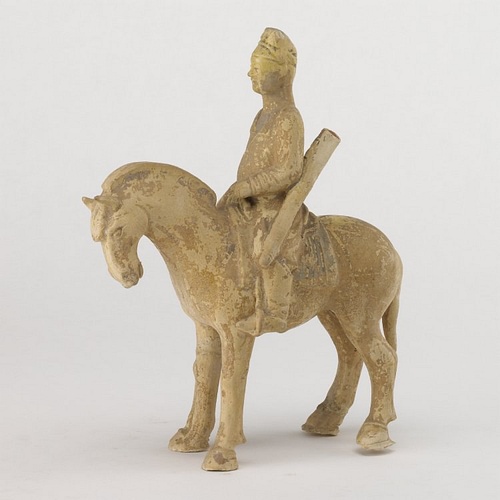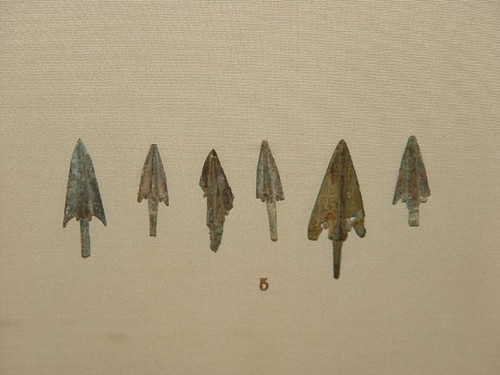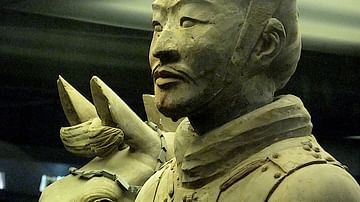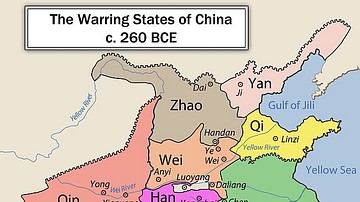The bow was the most common weapon in ancient Chinese warfare and the skill of using it was the most esteemed martial art for millennia. Archers were used as infantry, chariot riders, and cavalry over the centuries, and while the weapon's importance was challenged by the crossbow and sword, it remained a vital component of a commander's battlefield strategy, especially in the opening moves, retreat, and in the defence of cities.
Development & Associations
The bow was always an integral facet of Chinese culture, and the invention of the weapon was credited to one of two legendary cultural heroes depending on the source: the Yellow Emperor or Emperor Yi. Hunting with bows, however, dates back to prehistory with the first archaeological evidence from the Neolithic period. Hunting and firing from horseback was a common practice amongst the aristocracy in China, perhaps even during the Shang Dynasty (c. 1600 - 1046 BCE) and more certainly from the 5th century BCE onwards. The Shang, significantly, bestowed the title of “Archer-Lord” on the leaders of subjugated tribes, which is just one indicator of the high esteem the bow was held in ancient China, much as the sword was in western Europe. Archery competitions had also been a part of religious ceremonies and festivals held at the royal palace so that it is no surprise that the bow and arrow would one day make an appearance on the battlefield.
A symbol, then, of rulership and nobility, skill with the bow was expected to be displayed in various archery competitions. Warriors, senior officials and administrators had to prove their ability at archery, which was also thought to reveal the person's moral character. Nor were one's skills permitted to become rusty as junior army officers were required to pass an archery test each year.
In the Zhou dynasty (1046-256 BCE), and probably too in the preceding Shang dynasty, ornate bows with gold and jade additions, along with a matching 100 arrows, were given as a reward for military prowess on the battlefield or as a way for a ruler to confer an honour on a certain individual. By the Spring and Autumn period (722-479 BCE) there were two types of such honours: a red bow with 100 arrows and a black bow with 1,000 arrows.
It is also interesting to note that arrows were frequently placed in tombs, symbolic of their importance to the deceased in the next life. By the 6th century BCE, Confucius helped further embed archery in the national psyche by insisting it was one of the six essential arts of self-cultivation. Finally, Chinese literature abounds with stirring tales of archers pulling off impossible shots such as killing opponents with each rapidly fired shot, penetrating several layers of an enemy's armour, or just a few archers miraculously holding off a much larger infantry force.
Materials & Design
Designs of both bow and arrow varied over time and geographical location. The simplest bows were made of wood or horn (water buffalo was preferred) while composite bows already appeared from the Shang period onwards - that is bows made from up to eight pieces such as separate strips of bamboo glued together or bound using silk. Different woods used (often in the same bow) included silkwood thorn, wild mulberry, orange wood, and quince. All of these woods, bamboo, and horn were carefully selected and combined for their compression or elastic properties to give the maximum firing power. Glues were made from vegetable or animal matter, and later, fish glue was found to be the best. Animal sinew or tendon was used to cover the finished bow and increase its elasticity. The final stage was to cover the bow in lacquer which protected it from moisture. The string of the bow was likely made from twisted fibres of silk, leather or plant material, especially bamboo.
The recurved form of bow, which curved out symmetrically from the central handgrip, was already in use in the Shang period, too. Shang bows measured some 1.2 m (42 inches) in length, but later periods saw both smaller and larger versions (up to 1.65 m) used. Sometimes there were different sizes all available at the same time, and the decision as to which to use was based on the physique of the archer: the taller the man, the longer the bow. The arrows used with them had reed, cane, or bamboo shafts; sometimes wood was used, but they required much more work to produce. Arrows for the larger bows would have measured around 85 cm in length and had a diameter of around 1 cm. Feather (geese or duck), wood, or paper vanes were added to give extra stability in the arrow's trajectory; they typically measured 10 to 15 cm in length and were 2 cm high. An archer usually carried a minimum quiver of ten arrows when in battle.
Arrowheads were made first from stone (e.g. flints and obsidian), shell or bone, then bronze or copper and, finally, iron, but bone was a popular choice even in later times, being light and easy to carve. Those bronze arrowheads which survive from the Shang dynasty are around 9.5 cm long, have a long narrow shape tapering gradually to a point and a raised central spine which becomes thinner towards the edges either side. By the Zhou Period, arrowhead design had changed, probably influenced by developments in crossbow bolts, and they now were made shorter with a prominent central ridge to aid accuracy or with a third edge. The double projection at the back of the head which makes extraction more difficult is now more common, too. There is much debate on the penetrating power of arrows into the armour worn by soldiers, but when the latter was only made from leather, before metal plating was added in the Warring States period (c. 481-221 BCE), there are plenty of skeletal remains which show bones with deep wounds from arrows.
If the information we have on archery competitions relates to the battlefield, then it seems that an archer was expected to hit an opponent from a distance of at least some 76 metres (250 ft) and probably double that. The historian R. D. Sawyer makes the following comments regarding accuracy:
Exceptionally skilled archers could reputedly hit a flying bird at 200 paces, and superlative archers such as Yang Yu-chi in the Spring and Autumn period reportedly could hit a willow branch at 100 paces, giving rise to the phrase “penetrating a willow at a hundred paces” becoming praise for any extraordinary skill. (Sawyer, 2011, 311).
To what degree the ordinary archer on the battlefield could emulate these feats is unknown, but the Chinese did believe the skill could be acquired through practice, and so there were many training schools for archery, regarded as it was an essential skill for gentlemen for much of China's history.
Use in Warfare
The chariot was used on the battlefield from around 1250 BCE in Chinese warfare, and one of the riders was invariably an archer. Standing usually on the left side, he shared the cab with a driver and sometimes also a spear or halberd bearer. Infantry also carried a bow, as well as a spear and or halberd. The need for a great number of weapons and the lengthy time of manufacture meant that bows and arrowheads were manufactured on large scale by state-sponsored specialised workshops, even as early as the Shang dynasty. This was certainly so by the 7th century BCE when the battlefields of China first began to see massed volleys of arrows being fired in a single moment. Records of city arsenals show that at any one time tens of thousands of bows and millions of arrows were stored up for future use.
Archers were used as cavalry from the 4th-3rd century BCE onwards. The bow remained a popular infantry weapon, though, with the traditional squad of five consisting of three spearmen and two archers. Whether on horse or on foot, archers were typically stationed to protect the flanks of the infantry armed with spears and halberds. Cavalry riders were expected to shoot while at full gallop, no mean feat considering the primitive nature of saddles - usually only a rolled blanket - and with the arrival of stirrups only from the Han period (206 BCE - 220 CE). For this reason, many dynasties simply recruited experienced riders from neighbouring states; a policy which continued into the Three Kingdoms period (220-280 CE) and even later.
Archers typically opened the proceedings in a battle with the hope that a volley of arrows would deplete and soften up an opposing force before the more heavily armed infantry soldiers entered the fray. The bow was also seen as a great defensive weapon, notably when a city was under siege.
With the introduction of the crossbow into Chinese warfare from the Warring States period (481-221 BCE), the bow had a new challenger for the weapon of choice. The armies of the Han were particularly noted for their skills with the crossbow which could fire a bolt further and with much greater penetration than an arrow fired from a bow. However, by the Tang dynasty (618-907 CE) the traditional archer made a comeback, this time armed with an even more powerful composite bow than previously. Armies of the period, according to contemporary military treatises, fielded a ratio of bowmen to crossbowmen of 5:1. By the Song dynasty (960-1279 CE) the crossbow returned to favour as repeating models could now fire bolts every few seconds and fire them longer distances and more accurately than before. Nevertheless, the bow would remain an important weapon in Chinese armies right through the medieval period and into the 19th century CE.








